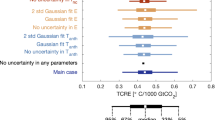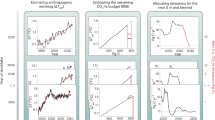Abstract
This paper formally introduces the concept of mitigation as a stochastic control problem. This is illustrated by applying a digital state variable feedback control approach known as Non-Minimum State Space (NMSS) control to the problem of specifying carbon emissions to control atmospheric CO2 concentrations in the presence of uncertainty. It is shown that the control approach naturally lends itself to integrating both anticipatory and reflexive mitigation strategies within a single unified framework. The framework explicitly considers the closed-loop nature of climate mitigation, and employs a policy orientated optimisation procedure to specify the properties of this closed-loop system. The product of this exercise is a control law that is suitably conditioned to regulate atmospheric CO2 concentrations through assimilating online information within a 25-year review cycle framework. It is shown that the optimal control law is also robust when faced with significant levels of uncertainty about the functioning of the global carbon cycle.
Similar content being viewed by others
References
Clarke DW (1994) Advances in model-based predictive control. In: Clarke DW (ed) Advances in Model-Based predictive Control. Oxford University Press, Oxford, pp 3–21
Collings IB, James MR and Moore JB (1994). An information-state approach to linear risk-sensitive quadratic Gaussian control. Proc 33rd IEEE Conf Decis Control 4:3802–3807, vol.4
Engsted T, Haldrup N (1999) Multicointegration in stock-flow models. Oxf Bull Econ Stat 61:237–254
Fiddaman TS (2002) Exploring policy options with a behavioral climate–economy model. Syst Dyn Rev 18
Franklin GF, Powell JD, Emami-Naeini A (2002) Feedback control of dynamic systems. Addison-Wesley
Hammitt JK, Lempert RJ, Schlesinger ME (1992). A sequential-decision strategy for abating climate change. Nature 357:315–318
Hare B, Meinshausen M (2006) How much warming are we committed to and how much can be avoided? Clim Change 75:111–149
Houghton JT, Meira Filho LG, Griggs DJ, Maskell K (1997) Stabilization of atmospheric greenhouse gases: physical, biological and socio-economic implications. IPCC Technical Paper III
Jarvis AJ, Young PC, Leedal DT, Chotai AC (2005) An incremental CO2 emissions strategy based on a state variable feedback control design. International Symposium on Stabilisation of Greenhouse Gases, Exeter, UK
Joos F, Bruno M, Stocker TF, Siegenthaler U, Le Quere C, Sarmiento JL (1996) An efficient and accurate representation of complex oceanic and biosphere models of anthropogenic carbon uptake. Tellus 48B:397–417
Kalman RE (1960) A new approach to linear filtering and prediction problems. Tranactions American Society of Mechanical Engineers, J Basic Eng 82-D:35–45
Keller K, Bolker BM, Bradford DF (2004). Uncertain climate thresholds and optimal economic growth. J. Environ Econ Manage 48:723–741
Leedal DT (2007) Sequential decision making in climate change mitigation: a control systems perspective. PhD thesis. Lancaster University
Lempert R, Schlesinger M (2000) Robust strategies for abating climate change. Clim Change 45:387–401
Maier-Reimer E, Hasselmann K (1987) Transport and storage of CO2 in the ocean – an inorganic ocean-circulation carbon cycle model. Clim Dyn 2:63–90
Nise NS (2004) Control systems engineering. Wiley, New York
Nordaus WD (1991) To slow or not to slow – the economics of the greenhouse effect. Econ J 101:920–937
Pacala S, Socolow R (2004) Stabilization wedges: solving the climate problem for the next 50 years with current technologies. Science 305:968–972
Richardson GP (1991) Feedback thought in social science and systems theory. University of Pennsylvania Press, Philadelphia
Taylor CJ, Chotai A, Young PC (2000) State space control system design based on non-minimal state variable feedback: further generalization and unification results. Int J Control 73:1329–1345
Taylor JT, Young PC, Chotai A (1996) PIP optimal control with a risk sensitive criterion. Control ’96, UKAC International Conference on Control, Exeter
Wang L, Young PC (2006) An improved structure for model predictive control using non-minimal state space realisation. J Process Control 16:355–371
Wigley TML (1991) A simple inverse carbon cycle model. Glob Biogeochem Cycles 5:373–382
Yohe G, Toth FL (2000) Adaptation and the guardrail approach to tolerable climate change. Clim Change 45:103–128
Young PC (1984). Recursive estimation and time series analysis. Springer, Berlin
Young PC (1999) Data-based mechanistic modelling, generalised sensitivity and dominant mode analysis. Comput Phys Commun 115:1–17
Young PC, Garnier H (2006) Identification and estimation of continuous-time, data-based mechanistic models for environmental systems. Environ Model Softw 21:1055–1072
Young PC, Behzhadi MA, Wang C, Chotai A (1987) Direct digital and adaptive control by input–output, state variable feedback. Int J Control 46:1867–1881
Author information
Authors and Affiliations
Corresponding author
Rights and permissions
About this article
Cite this article
Jarvis, A.J., Young, P.C., Leedal, D.T. et al. A robust sequential CO2 emissions strategy based on optimal control of atmospheric CO2 concentrations. Climatic Change 86, 357–373 (2008). https://doi.org/10.1007/s10584-007-9298-4
Received:
Accepted:
Published:
Issue Date:
DOI: https://doi.org/10.1007/s10584-007-9298-4




